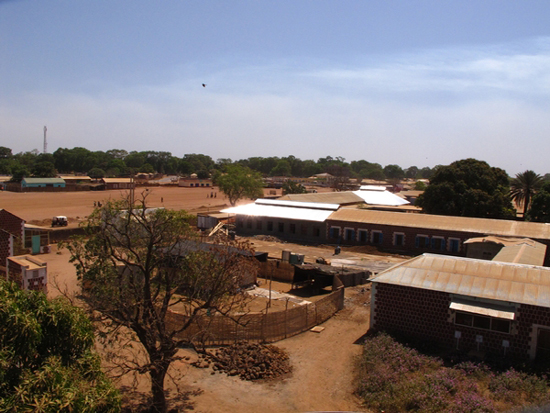In this latest post from her field blog, Dr. Veronica Ades tells the heartbreaking story of the death of a young patient in South Sudan.

South Sudan 2011 © Marion Martane
Patients in MSF's Aweil hospital, where Dr. Veronica Ades is working

Dr. Veronica Ades
Veronica Ades is an obstetrician-gynecologist on her first Doctors Without Borders/Médecins Sans Frontières (MSF) mission in Aweil, South Sudan.
Veronica is originally from New York City. She graduated from Wellesley College, and received her medical degree from the State University of New York at Downstate in Brooklyn, New York. She did her residency training in obstetrics and gynecology at the Albert Einstein College of Medicine in the Bronx, New York.
She is currently a fellow in reproductive infectious disease at the University of California, San Francisco. Veronica previously worked for one year at a rural district hospital in Uganda while doing research on malaria in pregnancy. Read her MSF Field Blog, "Love, Labor, Loss" here.
It is Tuesday, my first day on the job in Aweil. The outgoing OB-GYN is still here, and she is handling the hospital work today while I get my briefings from various people. Katie, the midwife who arrived with me, and I are getting a briefing with the head of mission: an abbreviated version of 200 years of Sudanese history. As the briefing wraps up, we get a message from the radio operator that maternity is looking for us.
When we arrive in the operating theater (OT), the patient is under anesthesia, and the outgoing OB-GYN (whom I am replacing) is attempting vaginal delivery. The patient is 18 years old. It is a full term pregnancy, and the baby is already dead. She has been in labor for 4 days. Since it didn’t come out during labor, we can assume it will be difficult to get out now.
We try the Kiwi vacuum. I like the Kiwi for normal deliveries, because it is easy to use, and doesn’t put too much pressure on the head; if you use too much force, the Kiwi just pops off. It’s like a safety check. If that happens a few times, it’s time to do a Caesarean section. But in this case, there is no such thing as too much force; the baby is already dead. And the Kiwi keeps popping off.
Next we try to use the forceps, which are metal graspers that are placed on either side of the baby’s head to guide it down. But the head is so wedged into the pelvis that we can’t get them on at all, despite multiple attempts by both of us.
Next we try the stronger vacuum, which has a large silicone suction cup and an external manual suction mechanism. It seems to have more force than the Kiwi. We pull and pull and pull. Slow progress is made. The other obgyn pulls on the suction cup while I hold the patient’s pelvis back to stop her from falling off the table. She is using all her strength. Finally, we deliver the dead fetus.
Because the patient has been in labor so long, there is a risk that she will have tissue necrosis and form an obstetric fistula. From below, her uterus is abnormally displaced upward in her abdomen, near her umbilicus. This is probably because most of the fetus was sitting in her vagina, not in her uterus or cervix, and the lower tissue is stretched out. We examine with a speculum, and the cervix looks relatively normal, although large and floppy. She is not bleeding. We are finished.
The anesthetist comments that the patient was already septic when she came in. This means that she had already developed a uterine infection from prolonged labor that had then spread into her blood stream, and had caused physiologic changes like low blood pressure and high heart rate as a sign of overwhelming infection. The anesthetist had to give the patient dopamine to improve her blood pressure during the procedure. She is not out of the woods yet; she will need strong antibiotics, good care, and a lot of luck.
We send her to the ward, and repeatedly check on her throughout the day. She is stabilizing. She has a fever, but we are giving her antibiotics and Tylenol. She is weak, but able to talk and her family is taking good care of her.
The next day she looks so-so. We are treating her infection and giving her IV fluid, but, most notably, her oxygen saturation is low at 91 percent (it should be 95 percent or higher). In combination with the low blood pressure and tachycardia (high heart rate), I am worried that she is decompensating. We put her on continuous supplemental oxygen. I ask for input from the anesthetist, and she gives me a vial of dopamine and a bag of normal saline, and explains how to give it. The idea is to artificially increase the patient’s blood pressure in order to maintain her organ function until her status improves. The patient’s nurse dutifully counts out the number of drops per minute, to carefully monitor the dopamine dose. Her blood pressure improves soon after starting dopamine. After lunch, we plan to reevaluate and possibly lower the dose gradually.
That afternoon, she looks worse. Her abdomen is swollen and she is complaining of abdominal pain. She is breathing fast and looks uncomfortable. Her oxygen saturation is getting worse. It is very likely that the sepsis is causing pulmonary dysfunction, called acute respiratory distress syndrome, or ARDS. Her blood pressure is OK on the dopamine, but when we lower the dose, the blood pressure drops quickly.
The anesthetist stops by as I am examining her, and we agree that her bowels probably aren’t functioning well as a result of the infection, and she needs a nasogastric (NG) tube. This tube gets inserted in the nose, goes down the esophagus and into the stomach. It allows us to decompress the stomach and bowels from above, since they are not emptying from below. The nurse races to get an NG tube, and we insert it successfully on the second attempt. We get a little fluid back. I am concerned about her condition and want another opinion, so I call the hospital manager (HM), who arrives immediately.
The HM finds a large syringe and is able to aspirate a lot of ugly fluid out of the NG tube. This visibly decompresses her stomach, but it doesn’t change her breathing, heart rate or blood pressure. At this point, the dopamine has run out and we need to decide whether to restart it. I am concerned about leaving her overnight with dopamine and no supervision from the nursing staff. The HM, the anesthetist, and I discuss the dopamine. The HM points out that the use of dopamine is not sustainable; we don’t have an intensive care unit setting and it is a powerful and dangerous drug that, although sometimes lifesaving, is probably out of our range of care options. It is fine for the acute setting, such as intraoperative resuscitation, but this patient is more than 24 hours out of surgery and we don’t have the ability to provide the intensive care necessary for dopamine. We agree that the patient needs aggressive IV fluid hydration, oxygen, and monitoring.
On Wednesday evening, I am in the hospital to do another surgery, and I stop by and look at the patient. She has decompensated. She is unconscious. Her vital signs are still bad. Her oxygen saturation is 83 percent. For some reason, the oxygen machine has been turned off. I turn it on, and her saturation improves to 90 percent. There is confusion as to who turned it off and why. Her nurse is frustrated because other staff members came by and turned it off. We speak to everyone we can, and let them know that it should not be turned off.
She is not febrile, but she is now suffering the effects of sepsis. She probably has multiple organ dysfunction, but we don’t have the lab tests needed to find out. Her lungs sound wet. Her blood pressure has improved after fluid hydration, but I realize that her sepsis must have allowed the fluid in her bloodstream to seep out of her blood vessels and into the “third spaces” of the body – in her case, the lungs. I start giving furosemide, a diuretic. We also change her position to have her sit straight up so that her lungs aren’t completely drowning in fluid. After multiple doses of furosemide, she puts out a lot of urine, and her oxygen saturation improves a lot. A few hours later, her lungs are more dry, although her saturation is not perfect – she still has ARDS.
I can’t wake her up. Even after improving her oxygen saturation, giving some concentrated glucose and suctioning her NG tube, she is unconscious. It doesn’t look good. Her blood pressure is very inconsistent. It varies within minutes from very low to normal to borderline elevated. I can’t think of anything else to do. I ask the anesthetist and the HM, but they don’t have any additional suggestions. There is only so much you can do in this setting.
Throughout the next day, I check on her repeatedly, and she looks worse and worse. Her heart rate shoots up to the 150s, and her breathing is extremely rapid and she gasps for air with each short breath, even though the saturation on supplemental oxygen is good.
I realize that she is probably going to die. I start preparing her family for this. I tell them, through a Dinka-speaking nurse, that we are doing everything we can, but she is probably going to die. They understand. Her father says “It is in God’s hands now.” Her mother and father both sit on her bed, each holding one of her hands, watching her carefully. They have been so dedicated throughout. When we asked them to hold on to the syringe for the NG tube, they wrapped it up carefully and hid it in the corner under a blanket so it wouldn’t get lost. They help us check her urine, or her oxygen saturation, or adjust her tubes. They are lovingly stoic.
It is only in this moment that I start to process the injustice of this. She is 18 years old. She was having her first baby. That is what is killing her.
It is hard to watch her like this. Although she is unconscious, she looks so uncomfortable. Her breathing is so effortful, so tortured. Her fever spikes again and I change her antibiotics. Now that her lungs are dry, I give a little IV fluid. I have nothing else. Every time I come to her bedside, I check her vital signs, her oxygen saturation, and then I shake my head and walk away. I don’t know what else to do. Eventually, I stop checking the vitals, and just gaze at her from the head of the bed. She is dying, and there is nothing I can do.
That night, I am in the OR late until 2:00 am. I check on her afterward. She is still alive, still heaving. Her family doesn’t even seem to sleep. They sit on her bed, holding her hands and watching her die painfully.
The next morning, I am told that she died at 4:00 am. She and her family were gone from the ward by morning.
In South Sudan, women have a lot of children and little access to care. Women mostly deliver at home, and when things go sour, they are very far from the nearest health center. A recent survey of a remote area nearby revealed that the nearest health center to that population was six hours away. So, when the baby doesn’t come out, the women just wait and suffer. They wait for days, because to get up and find help would be excruciating, and probably would not be very helpful anyway. That’s how four days go by, and a baby dies inside a vagina. By the time they reach someone that can actually help them, they are so sick that sometimes they are beyond help. We try anyway, and often, miraculously, they make it. Those are the ones that would die if we were not here. Then there are the ones that still die, too many of them, who would not have died if they had given birth in the countries that we come from.




